 |
 |
 |
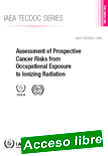 |
Assessment of Prospective Cancer Risks from Occupational Exposure to Ionizing Radiation
IAEA TECDOC No. 1985 ¦ 76 pages ¦ 6 figures ¦ Date published: 2021
Artificial sources of radiation are commonly used in the manufacturing and service industries, research institutions and universities, and the nuclear power industry. As a result, workers can be exposed to artificial sources of radiation. There are also a significant number of workers, such as underground miners and aircrew, who are exposed to naturally occurring sources of radiation.
|
This publication, prepared in collaboration with the International Labour Organization, and with reference to IAEA Safety Standards Series No. GSR Part 3 provides guidance for individuals and organizations on the assessment of prospective cancer risks due to occupational exposure to ionizing radiation for prevention purposes. It describes cancer risk assessment theory, models and methodologies, and offers practical examples of carrying out these assessments.
|
 |
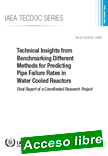 |
Technical Insights from Benchmarking Different Methods for Predicting Pipe Failure Rates in Water Cooled Reactors
IAEA TECDOC No. 1988 ¦ 126 pages ¦ 33 figures ¦ Date published: 2021
This publication presents the outcome of an IAEA coordinated research project (CRP) on methodologies for assessing pipe failure rates in advanced water cooled reactors. The goal of the CRP was to provide Member States with a strong technical basis for establishing nuclear power plant piping reliability parameters. To meet this goal two parallel and interrelated activities were carried out.
|
In a first CRP activity, the participating institutions performed a series of benchmark studies. These studies, as described in this publication, were formulated for the purpose of evaluating different methodologies when applied to a common problem. The results were compared, and the reasons for differences were identified. This publication provides a description of the benchmark studies, the participants' individual methodologies applied, and simulations and analyses carried out, an independent synthesis of the results, and the main insights and conclusions from the exercise.
|
 |
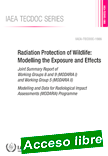 |
Radiation Protection of Wildlife: Modelling the Exposure and Effects
IAEA TECDOC No. 1986 ¦ 86 pages ¦ 3 figures ¦ Date published: 2021
This publication was produced as part of the IAEA's Modelling and Data for Radiological Impact Assessments (MODARIA I and MODARIA II) programmes. It summarizes the activities of the Working Groups that considered the application of modelling to estimate radiation exposure of wildlife, and the effects of such exposure on wildlife populations.
|
The fitness for purpose of available models and tools for estimating wildlife exposures was assessed. On the basis of the evaluations carried out, a number of models and tools are proposed for use by assessors and it can be concluded that the commonly used models are generally fit for purpose for screening level assessments. Modelling approaches for estimating population dynamics and radiation dose effects on populations of wildlife are also addressed.
|
 |
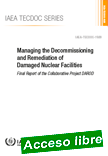 |
Managing the Decommissioning and Remediation of Damaged Nuclear Facilities: Final Report of the Collaborative Project DAROD
IAEA TECDOC No. 1989 ¦ 134 pages ¦ 11 figures ¦ Date published: 2021
As part of the Action Plan on Nuclear Safety, the IAEA led the International Project on Managing the Decommissioning and Remediation of Damaged Nuclear Facilities (DAROD Project). The DAROD Project focuses on providing practical guidance for the decommissioning and remediation of accident damaged nuclear facilities based on case studies of actual damaged facilities and lessons learned.
|
This publication summarizes the outcomes of the DAROD Project. It is intended for regulatory bodies, operating organizations, technical support organizations and governmental officials who are involved in the decommissioning and remediation of nuclear facilities damaged after an accident or owing to a legacy deterioration.
|
 |
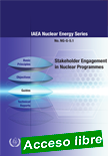 |
Stakeholder Engagement in Nuclear Programmes
IAEA Nuclear Energy Series NG-G-5.1 ¦ STI/PUB/1967 ¦ 63 pages ¦ 5 figures ¦ Date published: 2021
As stakeholder engagement is a recognized strategic element throughout the entire lifespan of nuclear facilities, the objective of this publication is to highlight the key principles of stakeholder engagement and to provide a practical guide for developing and implementing stakeholder engagement programmes. This publication provides theoretical and practical guidance on the development and implementation of stakeholder engagement programmes and activities.
|
It also includes tools such as templates to help establish a stakeholder engagement programme and identify associated activities, including tools for stakeholder analysis (behaviours, motivation and values). As such, it provides basic guidance which can be further developed and adjusted to each specific type of facility, moment in its life cycle, and/or the group of stakeholders with which to engage.ng stakeholder engagement programmes.
|
 |
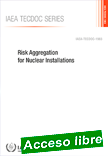 |
Risk Aggregation for Nuclear Installations
IAEA TECDOC No. 1983 ¦ IAEA-TECDOC-1983 ¦ 140 pages ¦ 53 figures ¦ Date published: 2021
The objective of this publication is to describe the practices and challenges in Member States related to risk aggregation for various hazards, various operational states, and taking into account all sources of potential radioactive releases at the nuclear installation site. This publication provides a methodology and technical basis on risk aggregation and identifies the good practices available in IAEA Member States.
|
Requirements for risk aggregation in the national legal and regulatory framework differ among Member States. The specifics of how risk aggregation is done in different Member States would be impacted by different requirements, e.g. safety goals established for specific risk metrics. Therefore, the information provided in this publication could be used by multiple stakeholders (regulatory body, utilities, public) in different regulatory contexts that will drive different requirements to perform aggregation of various risk contributors for nuclear installations.
|
 |
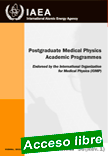 |
Postgraduate Medical Physics Academic Programmes
Training Course Series No. 56 (Rev. 1) ¦ IAEA-TCS-56 ¦ 36 pages ¦ Date published: 2022
The major objective of a postgraduate medical physics academic programme is to provide the students with a thorough grounding in medical physics, critical thinking, scientific rigor, and adequate professional ethics, to facilitate the integration of the graduates in a healthcare profession, where the benefit of the patient is at the centre of all activities.
|
This document aims to guide Member States in structuring a postgraduate-level academic programme in medical physics, and includes considerations pertaining to admission criteria, quality management and sustainability. The document comprises a list of knowledge sources for the core modules.
|
 |
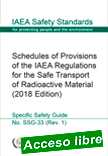 |
Schedules of Provisions of the IAEA Regulations for the Safe Transport of Radioactive Material (2018 Edition)
IAEA Safety Standards Series No. SSG-33 (Rev. 1) ¦ STI/PUB/1956 ¦ 299 pages ¦ 2 figures ¦ Date published: 2021
The objective of this Safety Guide is to provide information to aid users in determining the correct package type and the appropriate operational and administrative requirements to be applied. This Safety Guide can be used for all transport of radioactive material. It contains 26 schedules corresponding to the UN numbers and associated proper shipping names for the radioactive material to be shipped.
|
There may be deviations (i.e. exceptions and additions) from the Transport Regulations, necessitated by national and modal regulations and carrier restrictions, which are not reflected in this Safety Guide.
|
 |
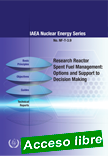 |
Research Reactor Spent Fuel Management: Options and Support to Decision Making
IAEA Nuclear Energy Series No. NF-T-3.9 ¦ STI/PUB/1954 ¦ English ¦ 123 pages ¦ Date published: 2021
This publication, resulting from an IAEA coordinated research project (CRP), provides information about available strategies for research reactor spent fuel management, and presents a decision methodology to assist those selecting among several options, to identify the preferred approach for their specific situation.
|
The decision support tools were developed to consider not only the cost of the possible research reactor spent fuel management strategies, but also the non-economic factors that might influence their selection. Examples of the technologies that are currently used by some IAEA Member States are provided. Additionally, this publication provides information about the Excel based decision-support tools developed as part of this CRP, along with case studies and tutorials to assist users.
|
 |
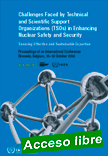 |
Challenges Faced by Technical and Scientific Support Organizations (TSOs) in Enhancing Nuclear Safety and Security: Ensuring Effective and Sustainable Expertise. Proceedings of an International Conference Held in Brussels, Belgium, 15-18 October 2018
STI/PUB/1955 ¦ English ¦ 258 pages ¦ Date published: 2021
This publication is the proceedings of an international conference which focused on evaluating actions that were undertaken to address recommendations from three previous technical and scientific support organizations (TSO) conferences and on the achievements of the TSO Forum.
|
The conference highlighted the importance of scientific and technical capabilities to support regulatory decision making for enhanced nuclear and radiation safety and security, and explored solutions for the development, maintenance, and enhancement of such capacities, especially in countries newly embarking on nuclear power programmes. In particular, the conference promoted the self assessment methodology developed by the IAEA to support Member States in developing their technical and scientific capabilities. The supplementary files, available on-line, contain the contributed papers and respective posters.
|
 |
| |
|
|

|
|
|
| |
|
|
| |
| |
|
|
| |
| |
|
|
| |
| |
|
|
|
| |
| |
